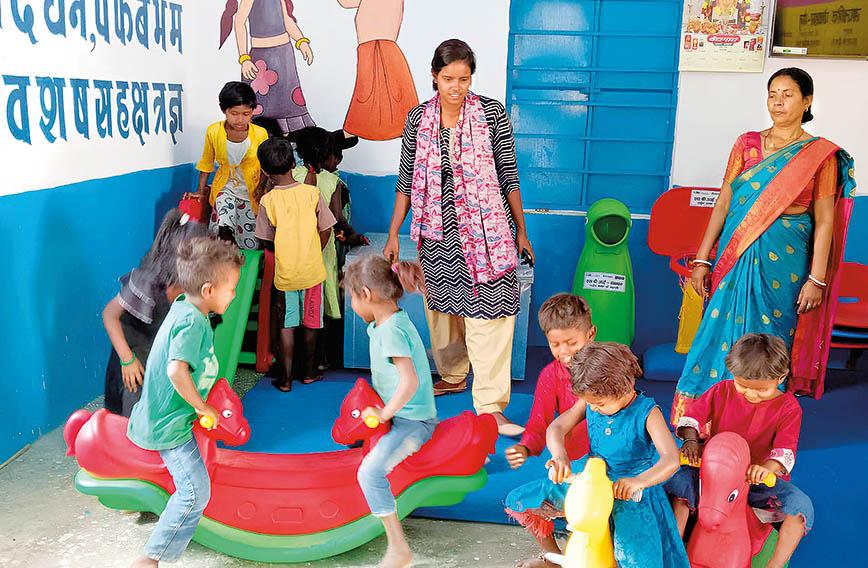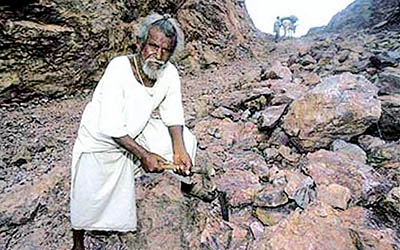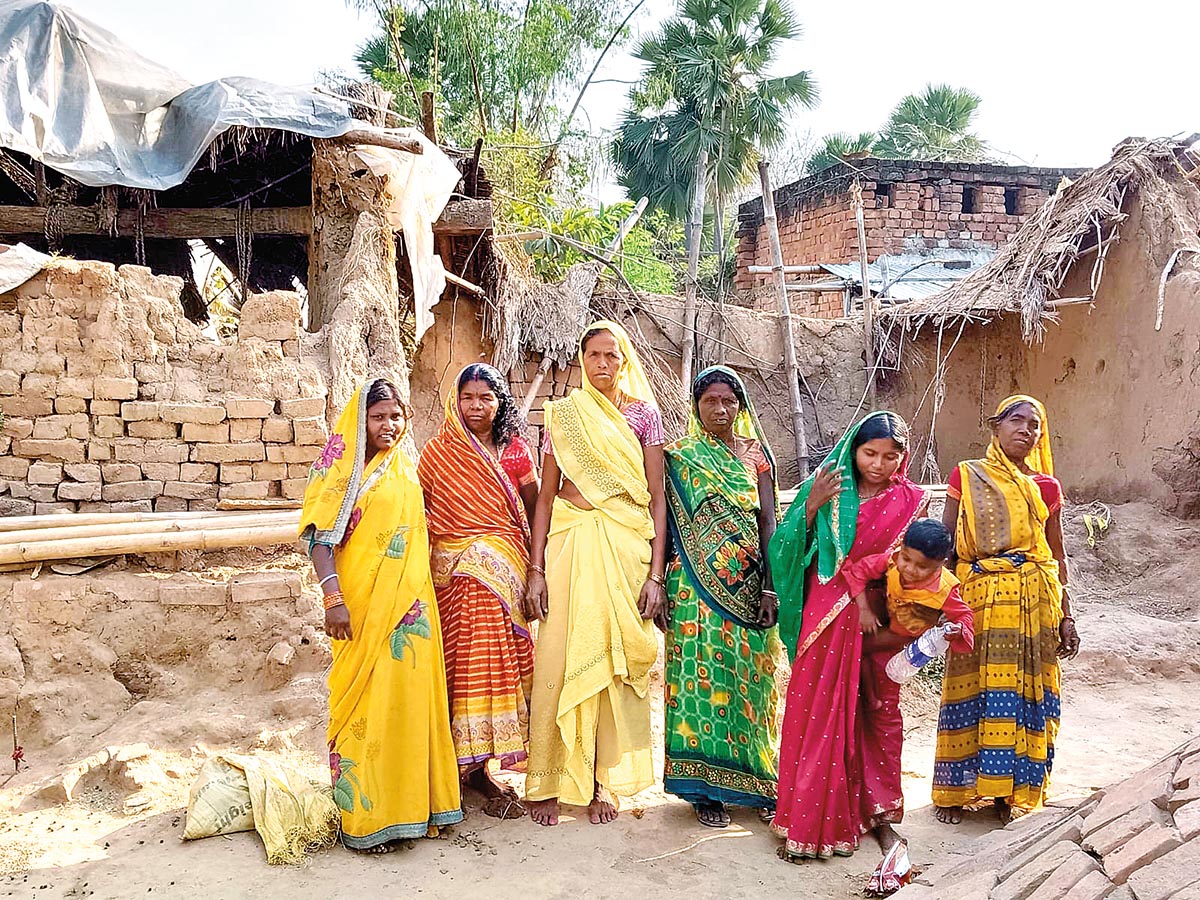
The village school has been upgraded with toys, computers, drinking water and solar lighting by the SBI Foundation
At Manjhi’s village there is another mountain to cross
Bharat Dogra, Gehlaur (Bihar)
THE legend of Dashrath Manjhi, India’s Mountain Man, is part of folklore. A labourer from the impoverished and landless Manjhi community settled in Gehlaur village in Gaya district of Bihar, he toiled for 22 years, from 1960 to 1982, to break down a huge mountain and carve out a road from his village. His wife, Falguni Devi, had died because he couldn’t get her to the nearest hospital in time. There was no road to take her to the nearby town of Atri because the mountain stood in the way. Manjhi began cutting through the rock, bit by bit, after his wife’s death.
For his stupendous achievement, Manjhi was honoured by the Government of India and the Bihar government. Movies and documentaries were made on his life.
Manjhi passed away in 2007. He spent his entire life working for his people and those living in nearby villages. He met Prime Minister Indira Gandhi and Chief Minister Nitish Kumar in his effort to uplift his destitute village and the surrounding hamlets. After his death, memorials and gates were built in his honour.
Seventeen years have passed since. Has poverty finally disappeared from Manjhi’s village? Is his region better off?
A recent trip to Gehlaur revealed mixed results. Important work in health, education and livelihoods has been earnestly carried out by the State Bank of India (SBI) Foundation under its corporate social responsibility (CSR) programme in partnership with a reputed voluntary organization, the Sahbhagi Shikshan Kendra.
But poverty has not gone away because the underlying reasons for deprivation are structural and need to be addressed by the State.
The SBI Foundation has a very well-thought-out programme called Sammaan which seeks to honour freedom fighters and those doing valiant and noble work by promoting development initiatives in their native places.
Its partner, the Sahbhagi Shikshan Kendra, is well known for its development projects and its capacity development programmes. The two organizations embarked on an 18-month programme in education, health and livelihoods in Gehlaur village.
The principal of a middle-level school in the village said happily that the SBI Foundation had gifted five computers, a smart inter-active board and a projector to the school. As a result, the learning levels of the rural children had improved. In a class being held with the help of the projector, students could see the content of their day’s lesson in an interesting visual form, guided by a teacher. Students said that learning is certainly more interesting today.
Sammaan has also provided better facilities for cleaner and cooler drinking water. The school has become more attractive with walls covered with writing that disseminates information about the life of Dashrath Manjhi. Solar lighting provided in the school has added to the security of the school at night, the principal added.
 |
|
Mountain Man Dashrath Manjhi |
Sammaan has paid special attention to the needs of pre-school children. This has taken two forms. First, it has helped to significantly improve the anganwadi where pre-school children gather every day. The centre has been repaired and upgraded. The anganwadi has toys, educational materials, better sitting facilities and murals to make it a colourful and joyful place where children like to come.
The second intervention for pre-school children is a new school which functions for about two hours daily. It has been set up very close to where some of the poorest people live so that their children can come there easily on their own. The children may not have a colourful room but it is a delightful experience to be with them. At the time of my visit, preparations were on to gift an educational and hygiene kit to each of the children attending the school.
In the health sector Sammaan is promoting safer and healthier maternity practices. The role of Anupriya, a nurse with specialization in safer maternity, is much appreciated by women from the poorest households. They say she is providing timely advice, ensuring proper medicines and nutrition, apart from distributing nutritious food. She accompanies the women to the nearest hospital for check-ups and delivery. The Sammaan programme has also provided a 24/7 ambulance to take women for institutional delivery and care to the hospital.
To improve livelihood options, Sammaan has arranged for free three-month courses in sewing for women and girls. Most of the 60 girls trained so far, including several from the poorest communities, have taken up part-time sewing work. A few have started their own shops, while others intend to do so very soon. If orders from garment manufacturers become available, the women said, they can extend their work and improve their income significantly.
In the colonies of some of the poorest communities, there is appreciation for the provision of goats under this programme — with nearly 100 women receiving goats. This help is supported by a trained pashu sakhi or village-level veterinary doctor providing healthcare for goats right up to community or hamlet level.
 Women of Manjhi’s village say they lack drinking water, their houses are ramshackle and the men have to migrate
Women of Manjhi’s village say they lack drinking water, their houses are ramshackle and the men have to migrate
A Gram Seva Kendra (Village Service Centre) has been set up very close to the panchayat office. This helps in three ways. First, the centre disseminates information on government development and welfare schemes among the villagers. Second, it helps people, particularly from poorer sections, to fill in forms and other documents to apply for these schemes. Third, the centre helps provide photo copies and print-outs which are needed while applying for such schemes, at a highly concessional rate. With various documents becoming more and more important for accessing such schemes, the facilitating role of such a centre can be very helpful.
Why then is the community still steeped in poverty?
Wider efforts are needed to effectively tackle the root causes of deprivation. If men from here do not go regularly to toil in exploitative conditions in brick kilns located in distant places, they are likely to face acute hunger. Currently, even the earnings from this group of migrant labour do not keep hunger away entirely for the Manjhis. The community also faces a shelter crisis. Housing is becoming more insecure and precarious.
This writer visited three settlements of Manjhis, who continue to be among the poorest people in the village. In all three hamlets, several people introduced themselves as close relatives of Dashrath Manjhi. Among these hamlets Manjhi Tola is of special significance as Dashrath Manjhi used to live there during the years when he was toiling to create a path through the mountain.
After he achieved fame he got land to which he shifted with his son. People in one part of this hamlet said they were being threatened with eviction by the forest department which was ordering them to leave.
In another part of the hamlet, people said the descendants of previous landowners were threatening them with eviction and collecting money from them arbitrarily. In the first six months of the year they faced a serious shortage of water which always worsens as summer advances. One hand pump was meeting the needs of 80 households, they said. On top of all this, people in this hamlet and adjacent ones have been sent accumulated electricity bills — some as high as `30,000 to `80,000.
The benefits of government schemes have reached only a few. There is threat of displacement due to road and highway widening. Some of the poorest households fear that they may not possess all the papers demanded for rehabilitation. A third hamlet, called Pokharpuraini, also suffers from an acute shortage of drinking water. Women walk a long distance to fetch water from a water source that may or may not have water. A woman said she had not had a bath for several days due to water scarcity. Another pointed out that water had to be fetched even for the goats.
People depend on exploitative work for survival. Migrant workers take an advance from the contractor or middleman at the time of leaving for distant places. They have to toil in very difficult conditions just to clear the advance. So when they return to their villages they have only meagre earnings to show for all their hard work. Even those closely related to Dashrath Manjhi’s family are very poor. The condition of other Dalit communities, for example, the Ravidasi community that lives very close to Manjhi Tola, is equally difficult.
Comments
-

Kirtee Shah - May 25, 2025, 6:07 a.m.
This Manjhi story is incredible. Unbelievable. Not that one questions the fact of it having happened or his heroism. But everything about the story has the elements that beat our familiar rationality, limits of believability. The length of his struggle—over two decades. The act of opening a mountain single handedly to create a passage. His primitive tools. His one-man-ness, solo act in the mission. And his inspiration, motivation and subject of resolve –his wife’s death in absence of a road to a hospital. Does this look less human, as we are more familiar with a common man's limitations than strengths? I remembered my favourite movie: Naya Daur. “ Sathi Hath Badhana Sathi Re”. But that was lot easier in comparison. The hero started alone alright. But soon was joined by many in making an alternative road. But then it was a reel and this was real! The main story of the village Gehlaur’s development, 17 years after Majhi’s death, is the familiar story. Poverty, backwardness, lack of progress as structural issues remain unaddressed, and NGOs and CSR fill in, as substitute, for the real actors and the formal resources. The question to ask is: Why is Majhi’s heroic, almost impossible and beyond human act, is not enough to carry one village? And mind you, it was a public infrastructure development act—building a road by cutting the rock: a state function, and it was a rare, unique story of people’s participation in development action. There is no second Majhi and we have 6,38, 000 villages to “develop”! .





